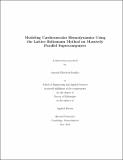| dc.contributor.advisor | Kaxiras, Efthimios | |
| dc.contributor.author | Randles, Amanda Elizabeth | |
| dc.date.accessioned | 2013-09-24T00:20:02Z | |
| dc.date.issued | 2013-09-23 | |
| dc.date.submitted | 2013 | |
| dc.identifier.citation | Randles, Amanda Elizabeth. 2013. Modeling Cardiovascular Hemodynamics Using the Lattice Boltzmann Method on Massively Parallel Supercomputers. Doctoral dissertation, Harvard University. | en_US |
| dc.identifier.other | http://dissertations.umi.com/gsas.harvard:10946 | en |
| dc.identifier.uri | http://nrs.harvard.edu/urn-3:HUL.InstRepos:11095963 | |
| dc.description.abstract | Accurate and reliable modeling of cardiovascular hemodynamics has the potential to improve understanding of the localization and progression of heart diseases, which are currently the most common cause of death in Western countries. However, building a detailed, realistic model of human blood flow is a formidable mathematical and computational challenge. The simulation must combine the motion of the fluid, the intricate geometry of the blood vessels, continual changes in flow and pressure driven by the heartbeat, and the behavior of suspended bodies such as red blood cells. Such simulations can provide insight into factors like endothelial shear stress that act as triggers for the complex biomechanical events that can lead to atherosclerotic pathologies. Currently, it is not possible to measure endothelial shear stress in vivo, making these simulations a crucial component to understanding and potentially predicting the progression of cardiovascular disease. In this thesis, an approach for efficiently modeling the fluid movement coupled to the cell dynamics in real-patient geometries while accounting for the additional force from the expansion and contraction of the heart will be presented and examined. First, a novel method to couple a mesoscopic lattice Boltzmann fluid model to the microscopic molecular dynamics model of cell movement is elucidated. A treatment of red blood cells as extended structures, a method to handle highly irregular geometries through topology driven graph partitioning, and an efficient molecular dynamics load balancing scheme are introduced. These result in a large-scale simulation of the cardiovascular system, with a realistic description of the complex human arterial geometry, from centimeters down to the spatial resolution of red-blood cells. The computational methods developed to enable scaling of the application to 294,912 processors are discussed, thus empowering the simulation of a full heartbeat. Second, further extensions to enable the modeling of fluids in vessels with smaller diameters and a method for introducing the deformational forces exerted on the arterial flows from the movement of the heart by borrowing concepts from cosmodynamics are presented. These additional forces have a great impact on the endothelial shear stress. Third, the fluid model is extended to not only recover Navier-Stokes hydrodynamics, but also a wider range of Knudsen numbers, which is especially important in micro- and nano-scale flows. The tradeoffs of many optimizations methods such as the use of deep halo level ghost cells that, alongside hybrid programming models, reduce the impact of such higher-order models and enable efficient modeling of extreme regimes of computational fluid dynamics are discussed. Fourth, the extension of these models to other research questions like clogging in microfluidic devices and determining the severity of co-arctation of the aorta is presented. Through this work, a validation of these methods by taking real patient data and the measured pressure value before the narrowing of the aorta and predicting the pressure drop across the co-arctation is shown. Comparison with the measured pressure drop in vivo highlights the accuracy and potential impact of such patient specific simulations. Finally, a method to enable the simulation of longer trajectories in time by discretizing both spatially and temporally is presented. In this method, a serial coarse iterator is used to initialize data at discrete time steps for a fine model that runs in parallel. This coarse solver is based on a larger time step and typically a coarser discretization in space. Iterative refinement enables the compute-intensive fine iterator to be modeled with temporal parallelization. The algorithm consists of a series of prediction-corrector iterations completing when the results have converged within a certain tolerance. Combined, these developments allow large fluid models to be simulated for longer time durations than previously possible. | en_US |
| dc.description.sponsorship | Engineering and Applied Sciences | en_US |
| dc.language.iso | en_US | en_US |
| dash.license | LAA | |
| dc.subject | Physics | en_US |
| dc.subject | cardiovascular hemodynamics | en_US |
| dc.subject | fluid dynamics | en_US |
| dc.subject | heart disease | en_US |
| dc.subject | high performance computing | en_US |
| dc.subject | lattice boltzmann | en_US |
| dc.subject | shear stress | en_US |
| dc.title | Modeling Cardiovascular Hemodynamics Using the Lattice Boltzmann Method on Massively Parallel Supercomputers | en_US |
| dc.type | Thesis or Dissertation | en_US |
| dash.depositing.author | Randles, Amanda Elizabeth | |
| dc.date.available | 2013-09-24T00:20:02Z | |
| thesis.degree.date | 2013 | en_US |
| thesis.degree.discipline | Applied Physics | en_US |
| thesis.degree.grantor | Harvard University | en_US |
| thesis.degree.level | doctoral | en_US |
| thesis.degree.name | Ph.D. | en_US |
| dc.contributor.committeeMember | Pfister, Hanspeter | en_US |
| dc.contributor.committeeMember | Brenner, Michael | en_US |
| dash.contributor.affiliated | Randles, Amanda Elizabeth | |


